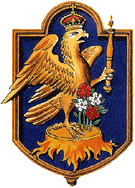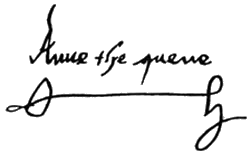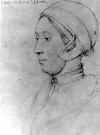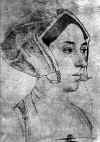


ANNE BOLEYN
M. Pembroke/Queen of England
![]()
Born: ABT 1501/1507, Blickling Hall, Norfolk, England
Acceded: 1 Jun 1532
Died: 19 May 1536, Tower of London, England
Buried: Chapel Royal, Tower of London, England
Father: Thomas BOLEYN (1° E. Wiltshire)
Mother: Elizabeth HOWARD (C. Wiltshire)
Married: HENRY VIII TUDOR (King of England) Jan / Mar 1533, Westminster, London, England ANNULMENT 1536
Children:
1. ELIZABETH I TUDOR (Queen of England)
2. Henry TUDOR (D. Cornwall) (b. Jul 1534)
3. Son TUDOR (b. 29 Jan 1536)
Painting of Anne
by an unknown artist
At Hever Castle, Kent
Anne Boleyn was probably born in 1500 or 1501. Her father was an English diplomat, Sir Thomas Boleyn, and her mother, Elizabeth, was the daughter of one of the powerfull families of that time.
|
Anne spent part of her childhood at the court of the Archduchess Margaret of Austria, the regent of the Netherlands. Fraser puts her age at 12-13, as that was the minimum age for a 'fille d'honneur'. It was from there that she was transferred to the household of Mary, Henry VIII's sister, who was married to Louis XII of France. Anne's sister Mary was already in 'the French Queen's' attendance. However, when Louis died, Mary Boleyn returned to England with Mary Tudor, while Anne remained in France to attend Claude, the new French Queen. Anne remained in France for the next 6 or 7 years. Because of her position, it is possible that she was at the Field of Cloth of Gold, the famous meeting between Henry VIII and the French King, Francois I. During her stay in France she learned to speak French fluently and developed a taste for French clothes, poetry and music. Anne returned to England around 1521 for details for her marriage with the heir of the earldom of Ormonde, in Ireland, were being worked out. Meanwhile she went to court to attend Queen Catalina. Her first recorded appearance at Court was Mar 1, 1522 at a masque. |

A sketch of Anne
Boleyn. She may have been pregnant
atthe time the drawing was made. |
After her marriage to the heir of the Earl of Ormonde fell through, she began an affair with Henry Percy, heir of the earldom of Northumberland.
They became secretly betrothed because Percy was already promised to Mary Talbot, daughter of the Earl of Shrewsbury, and his family would not approve of his marrying the less aristocratic Anne Boleyn. But the lord chancellor, Cardinal Wolsey, heard of the engagement and alerted the King, who told Wolsey to end the relationship. Wolsey did just that, lecturing Percy for becoming involved with a "foolish girl" and summoning Percy's father, who forbade him to see Anne again. Percy was forced to marry Mary Talbot, and Anne never forgave Wolsey.
Anne was banished from the royal court after the abrupt ending of her romance with Percy and did not return until 1524 or 1525. Somewhere in this time, Anne also had a relationship of some sort with the poet Sir Thomas Wyatt. Wyatt had married Elizabeth Brooke, Lord Cobham´s daughter, in 1520, so the timing of the supposed affair is uncertain. Wyatt was separated from his wife, but their could be little suggestion of his eventual marriage to Anne. Theirs appears to be more of a courtly love.
Exactly when and where Henry VIII first noticed Anne is not known. It is likely that Henry sought to make Anne his mistress, as he had her sister Mary years before. Maybe drawing on the example of Elizabeth Woodville, Queen to Edward IV (and maternal grandmother to Henry VIII) who was said to have told King Edward that she would only be his wife, not his mistress, Anne denied Henry VIII sexual favors. "I would rather lose my life than my honesty". We don't know who first had the idea marriage, but eventually it evolved into "Queen or nothing" for Anne.
|
A miniature of Anne before Queen (about age 25) |
At first, the court probably thought that Anne would just end up as another one of Henry's mistresses. But, in 1527 we see that Henry began to seek an annulment of his marriage to Catalina, making him free to marry again. King Henry's passion for Anne can be attested to in the love letters he wrote to her when she was away from court. Henry hated writing letters, and very few documents in his own hand survive. However, 17 love letters to Anne remain and are preserved in the Vatican library. The legend of Anne Boleyn always includes a sixth finger and a large mole or goiter on her neck. However, one would have to wonder if a woman with these oddities (not to mention the numerous other moles and warts she was said to have) would be so captivating to the King. She may have had some small moles, as most people do, but they would be more like the attractive 'beauty marks'. Ambassador and courtiers described her in his letters. She was considered moderately pretty. But, one must consider what 'pretty' was in the 16th century. Anne was the opposite of the pale, blonde-haired, blue-eyed image of beauty. She had dark, olive-colored skin, thick dark brown hair and dark brown eyes which often appeared black. Those large dark eyes were often singled out in descriptions of Anne. She clearly used them, and the fascination they aroused, to her advantage whenever possible. |
|
She was of average height, had small breasts and a long, elegant neck. The argument continues as to whether or not she really had an extra finger on her left hand. In 1528, Anne's emergence at Court began. Anne also showed real interest in religious reform and may have introduced some of the 'new ideas' to Henry, and gaining the hatred of some members of the Court. When the court spent Christmas at Greenwich that year, Anne was lodged in nice apartments near those of the King. The legal debates on the marriage of Henry and Catalina de Aragon continued on. Anne was no doubt frustrated by the lack of progress. Her famous temper and tongue showed themselves at times in famous arguments between her and Henry for all the court to see. Anne feared that Henry might go back to Catalina if the marriage could not be annulled and Anne would have wasted time that she could have used to make an advantageous marriage. Anne was not popular with the people of England. They were upset to learn that at the Christmas celebrations of 1529, Anne was given precedence over the Duchesses of Norfolk and Suffolk, the latter of which was the King's own sister, Mary. |

Another sketch of Anne
by Hans Holbein the Younger |
In this period, records show that Henry began to spend more and more on Anne, buying her clothes, jewelry, and things for her amusement such as playing cards and bows and arrows.
The waiting continued and Anne's position continued to rise. On the first day of Sep 1532, she was created Marquess of Pembroke, a title she held in her own right. In Oct, she held a position of honor at meetings between Henry and Francois I, the French King in Calais.
|
"Anna Bullen" |
Bewitched by Anne's sparkling black eyes, long dark hair and vivacious personality, the King began scheming to end his marriage to Catalina. He claimed that it had never really been a marriage because she had been his brother's wife. Catalina insisted that her first marriage didn't count because it hadn't been consummated, and church authorities agreed. For years Henry struggled unsuccessfully to have his marriage annulled. In the end, determined to have his way, he broke free of the Catholic Church, established the Church of England, banished Catalina from court, had his first marriage declared invalid, and married Anne Boleyn. Queen Anne was crowned in Jun 1533. After Anne’s coronation, a large feast was held. To the Queen’s right stood her aunt Anne Howard, dowager Countess of Oxford, and to her left, Elizabeth Somerset, Countess of Worcester .Later that year she gave birth to her only surviving child, Elizabeth. The years of waiting had been hard on Anne. She was in her thirties now, moody and sharp tongued, and Henry was falling out of love with her. She had friends at court, but also many enemies. She had brought about the downfall of Cardinal Wolsey, who died in 1530, and she also plotted against Catalina de Aragon and her daughter Mary. |
Catalina died on 7 Jan 1536, and Anne rejoiced. She was pregnant again, and if she gave birth to a healthy son her position as Queen would be secure. But on the day of Catalina's funeral Anne found the King with one of her maids of honor, Jane Seymour, sitting on his knee. She became hysterical and had a miscarriage. "She has miscarried of her savior", the Spanish Ambassador wrote.
Anne's enemies at court began to plot against her using the King's attentions to Jane Seymour as the catalyst for action. Cromwell began to move in action to bring down the Queen. He persuaded the King to sign a document calling for an investigation that would possibly result in charges of treason.
On 30 Apr 1536, Anne's musician and friend for several years, Mark Smeaton, was arrested and probably tortured into making 'revelations' about the Queen. Next, Sir Henry Norreys was arrested and taken to the Tower of London. Then the Queen's own brother, George Boleyn, Lord Rochford was arrested.
On 2 May, the Queen herself was arrested at Greenwich and was informed of the charges against her: adultery, incest and plotting to murder the King. She was then taken to the Tower by barge along the same path she had traveled to prepare for her coronation just three years earlier. In fact, she was lodged in the same rooms she had held on that occasion. According to a letter from John Husee, Viscount Lisle's man of business in London, dated 24 May 1536, "the first accusers" against Queen Anne Boleyn were "the Lady Worcester, and Nan Cobham and one maid more". Lady Worcester was Elizabeth Browne, wife of the Earl of Worcester, but "Nan Cobham" is more difficult to identify. A letter written by Queen Anne to her long time firend, Bridget Wiltshire, lady Wingfield, was used as evidence in the trial of the Queen for adultery, incest and conspiring against the life of the King. As Bridget had died, she could not refute the interpretation the prosecution placed on the Queen's words:
'I pray you as you love me, to give credence to my servant this bearer, touching your removing and any thing else that he shall tell you on my behalf; for I will desire you to do nothing but that shall be for your wealth. And, madam, though at all time I have not showed the love that I bear you as much as it was in deed, yet now I trust that you shall well prove that I loved you a great deal more than I fair for. And assuredly, next mine own mother I know no woman alive that I love better, and at length, with God's grace, you shall prove that it is unfeigned. And I trust you do know me for such a one that I will write nothing to comfort you in your trouble but I will abide by it as long as I live. And therefore I pray you leave your indiscreet trouble, both for displeasing of God and also for displeasing of me, that doth love you so entirely. And trusting in God that you will thus do, I make an end. With the ill hand of Your own assured friend during my life, Anne Rochford'
There were several more arrests. Sir Francis Weston and William Brereton were charged with adultery with the Queen. They were put on trial with Smeaton and Norreys at Westminster Hall on 12 May 1536. The men were not allowed to defend themselves, as was the case in charges of treason. They were found guilty and received the required punishment: they were to be hanged at Tyburn, cut down while still living and then disemboweled and quartered. Sir Thomas Wyatt and Sir Richard Page were also arrested, but later released.
On Monday the 15th, the Queen and her brother were put on trial at the Great Hall of the Tower of London. It is estimated that some 2000 people attended. Anne conducted herself in a calm and dignified manner, denying all the charges against her. Her brother was tried next, with his own wife, Jane Parker, testifying against him (she got her due later in the scandal of Catherine Howard). Even though the evidence against them was scant, they were both found guilty, with the sentence being read by their uncle, Thomas Howard , the Duke of Norfolk. They were to be either burnt at the stake (which was the punishment for incest) or beheaded, at the discretion of the King.
|
On 17 May, George Boleyn was executed on Tower Hill. The other four men condemned with the Queen had their sentences commuted from the grisly fate at Tyburn to a simple beheading at the Tower with Lord Rochford. Anne knew that her time would soon come and started to become hysterical, her behavior swinging from great levity to body- wracking sobs. She received news that an expert swordsman from Calais had been summoned, who would no doubt deliver a cleaner blow with a sharp sword than the traditional axe. It was then that she made the famous comment about her 'little neck'. Interestingly, shortly before her execution on charges of adultery, the Queen's marriage to the King was dissolved and declared invalid. One would wonder then how she could have committed adultery if she had in fact never been married to the King, but this was overlooked, as were so many other lapses of logic in the charges against Anne. They came for Anne on the morning of 19 May to take her to the Tower Green, where she was to be afforded the dignity of a private execution. |
Miniature of Anne Boleyn |
Sir William Kingston, Constable of the Tower, wrote to Thomas Cromwell (spelling modernized):
This morning she sent for me, that I might be with her at such time as she received the good Lord, to the intent I should hear her speak as touching her innocency alway to be clear. And in the writing of this she sent for me, and at my coming she said, "Mr. Kingston, I hear I shall not die afore noon, and I am very sorry therefore, for I thought to be dead by this time and past my pain ". I told her it should be no pain, it was so little. And then she said, "I heard say the executioner was very good, and I have a little neck", and then put her hands about it, laughing heartily. I have seen many men and also women executed, and that they have been in great sorrow, and to my knowledge this lady has much joy in death. Sir, her almoner is continually with her, and had been since two o'clock after midnight.
She wore a red petticoat under a loose, dark grey gown of damask trimmed in fur. Over that she was a mantle of ermine. Her long, dark hair was bound up under a simple white linen coif over which she wore her usual headdress. She made a short speech before kneeling at the block, recorded by Edward Hall:
Good Christian people, I am come hither to die, for according to the law, and by the law I am judged to die, and therefore I will speak nothing against it. I am come hither to accuse no man, nor to speak anything of that, whereof I am accused and condemned to die, but I pray God save the King and send him long to reign over you, for a gentler nor a more merciful prince was there never: and to me he was ever a good, a gentle and sovereign lord. And if any person will meddle of my cause, I require them to judge the best. And thus I take my leave of the world and of you all, and I heartily desire you all to pray for me. O Lord have mercy on me, to God I commend my soul.
After being blindfolded and kneeling at the block, she repeated several times: To Jesus Christ I commend my soul; Lord Jesu receive my soul.
Her ladies removed the headdress and tied a blindfold over her eyes. The sword itself had been hidden under the straw. The swordsman cut off her head with one swift stroke.
Anne's body and head were put into an arrow chest and buried in an unmarked grave in the Chapel of St. Peter ad Vincula which adjoined the Tower Green. Her body was one that was identified in renovations of the chapel under the reign of Queen Victoria, so Anne's final resting place is now marked in the marble floor.
Anne Boleyn was not Henry's only queen to suffer his personal wrath and die by his decree. Catherine Howard, Henry's fifth wife, also suffered embarrassment and injury when she was accused of infidelity and treason. Henry's lawyer used a letter she had written to Thomas Culpepper as evidence to convict her of the charges.